| Home | Rides | Reviews | Bikes | Gallery | Tech | Misc | Contact |
| Back in Black? You may like the Johnny Cash look but you'll cook in the sun. by Martin Hackworth Photos: Martin Hackworth |
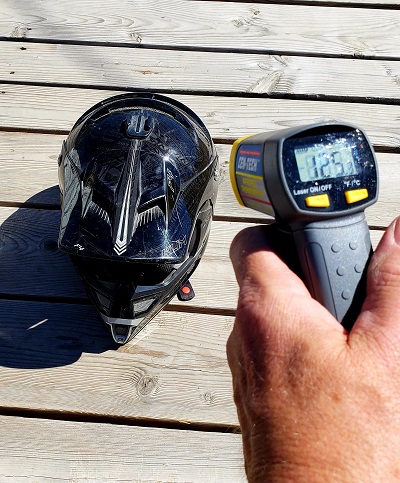 Temperature:
1250F
|
|
|
| I preface all articles that
I write on the subject of motorcycle
physics
with the two things in the world that everyone knows: 1) their own name
and 2) everything there is to know about physics. Much has
been written about the death of expertise in the "my ideas on things I
know nothing about are just as
good as yours" Interwebs age. I feel some of you ready to fire up those
keyboards
right now in mere anticipation of a brouhaha. That being the case I'll
say this as delicately as I
can. Probably you are not an expert in the physics
black bodies no
matter how much time you spend on Wikipedia trying to prove that Cold
Fusion works and Aliens from space are real. That said, I'm all about reasonable and/or thoughtful questions and insights about this or anything else related to motorcycle physics (to ask just go to the Reader Forum). To be clear what I am specifically not interested in are your ideas on how quantum mechanics proves the postmodern view that all knowledge is relative so you are an expert in physics even though you make a living walking dogs. Go pester someone else. The path toward enlightenment begins with listening, young Grasshopper. Now that we've got that out of the way let's discuss the effect of color on temperature response in motorcycle clothing. It makes more of a difference than you might think. I'd like to acknowledge and thank the folks at KLIM for allowing me to work with them on products in order to improve how they work. KLIM and most motorcycle clothing companies understand what we are about to get into. But sales drive marketing and marketing drives design. As long as fashion trumps function among a critical mass of consumers they'll have to keep giving the customer what they want. It's up to you to change the narrative. Sunlight consists of a spectrum of individual colors that when combined in equal amounts produce white light. Sunlight or natural light is white. You see the sun with a slight yellowish tinge at midday because some of the blue light is scattered in the atmosphere (the reason the sky is blue). |
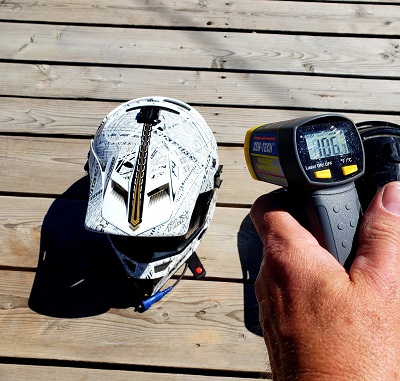 Temperature:
1060F
|
| Color is not
an innate property of objects. It is a property of the interplay between the object
and the
illuminating light. Turn off
the lights in an interior room of a building and everything
has the same
color - black. Nonetheless we all recognize a red car as a red car* (sans any color-blindness) because under natural light a red car absorbs every color of the illuminating light except red - which is reflected (or scattered) back to our eyes. In most cases, as it turns out, the color of an object is directly related to what portion of the illuminating light it rejects, rather than what it absorbs. An object that is white under natural light reflects all colors of the visible spectrum. An object that is black under natural light absorbs all colors of the visible spectrum. Because rays of light carry energy (which is why solar power works), an object that absorbs light is also absorbing energy. White objects absorb very little light energy while black objects absorb a lot. Here's where things get a bit complicated. An object can't just continuously absorb energy without some response. That would violate the laws of thermodynamics. Generally what happens is that as an object absorbs energy from sunlight its temperature increases. When you put an object out in the sun it gets hot. Darker objects get hotter than lighter objects because they absorb more light energy. The reason a swimming pool deck is always white is because walking on a black deck on a hot, sunny day would result in first degree burns to the soles of one's feet. The longer you leave a dark object in sunlight the hotter it becomes. But there has to be some mechanism for a dark object to do something besides just absorb energy and keep getting hotter or every dark solid would eventually melt in direct sunlight. Most dark solids act approximately like a class of objects known as black bodies. A black body has several interesting properties but the one that's relevant to our discussion is its ability to convert the energy from visible light to infrared light, aka, heat rays. Infrared light is not visible to the eye but it can be felt. If you turn on an element of an electric range and place your hand anywhere near it you can feel the infrared heat that it's producing. We're almost done. A dark object absorbing light energy will come to equilibrium (energy in = energy out) when the energy it absorbs in the form of direct sunlight is balanced by the energy it emits as infrared. To summarize, a dark object in sunlight absorbs all of the light that falls on it. It responds by increasing its temperature, but only up to the point where it comes to equilibrium. It then maintains equilibrium by radiating away the energy left over from increasing its temperature as infrared light. If you wear dark clothing in direct sunlight not only does the clothing get hot, conducting heat directly into your body, but the clothing also produces copious amounts of additional infrared energy. Some of this energy is radiated away from you but some of it is directed into your body making you even hotter. On cooler days dark clothing can be used to good effect. All of my uninsulated shells are black because the light they absorb, even on a cloudy day, will be partially converted to infrared and keep me warmer than an identical shell made of a lighter color - exactly what you want in a sudden summer shower. This doesn't work as well with heavier winter garments because the insulating layers largely prevent infrared rays from passing through in either direction. The accompanying photos were taken at noon on an 850F day under clear, sunny skies. I placed the objects to be measured in sunlight for about 30 minutes prior to taking their temperature to allow them to come to equilibrium. The background was chosen because it didn't affect the measurements. Note that in each case the equilibrium temperature for the darker color is well above ambient temperature. As you can see the temperature differences are substantial between the darker and lighter colored objects - in the case of the jersey nearly 300F! Not only will you to feel this increased temperature by virtue of conduction, but the additional infrared heating will be substantial. It's a true double whammy. You might think that the helmet, with it's dual energy absorbing and comfort linings that block some of the infrared and most of the conducted heat, would not cook your noggin as much - but you'd be wrong. A dark colored helmet on a warm, sunny day becomes a veritable oven for you head whenever the airflow through it slows down or stops. You should always remove a dark helmet from your head whenever you stop on a warm, sunny day. Dark boots are even worse. So do yourself a favor and get lighter colored garments for warm weather. White, silver, lighter grays - anything but black, dark red, dark blue, etc. The choice of color turns out, in most instances, to be at least as important as ventilation. A garment that is very well ventilated can end up completely knackered by its color on a warm, sunny day. Change the narrative! Knowledge is power! |
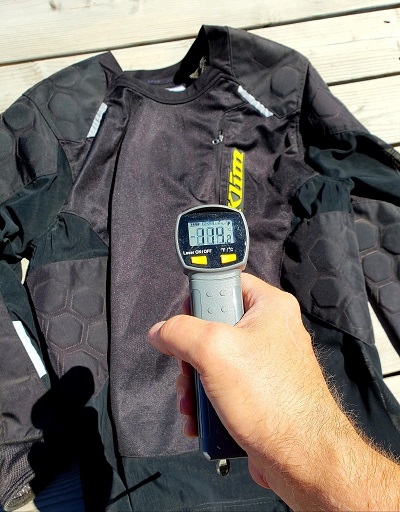 Temperature: 1140F 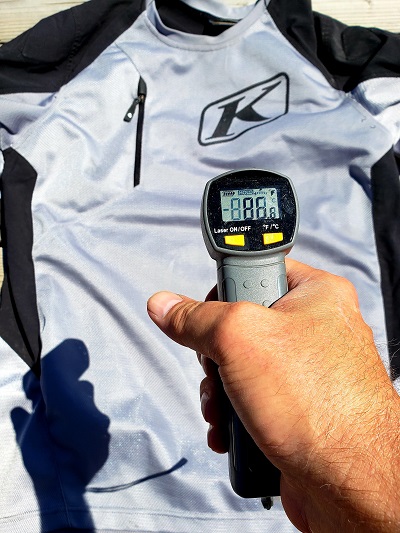 Temperature: 860F |
Reader Forum |
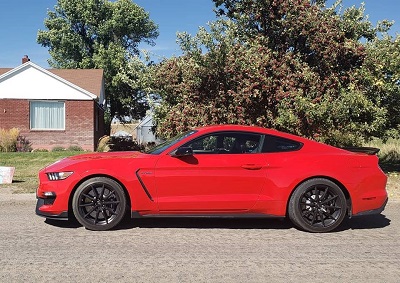 * "Maroon car my ass, this mofo is red." - Used Cars |
| Home | Rides | Reviews | Bikes | Gallery | Tech | Misc | Contact |
